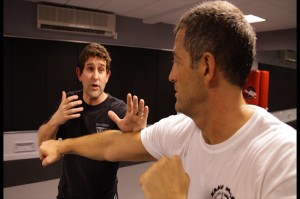
Defenses against straight punches are among the most difficult skills to acquire. If it seems we spend a lot of time training Inside Defenses, you’re right, we do. This skill is both hard-earned and perishable; you can’t train it enough. Inside Defense is a cornerstone of the Level 1 curriculum because the concept and mechanics are foundational to many higher-level Krav Maga techniques. Think about it as the opposite of the Patches O’Houlihan approach…
Note that what follows is a discussion of the technical aspects of Inside Defense, not a tutorial. There is no substitute for qualified instruction and hard training!
Everything starts with a good fighting stance.
Keep in mind that Inside Defenses are defenses from a prepared position against straight punches that are traveling inside our hand position (i.e. between our hands). If we are making an Inside Defense, it means that we acknowledged a threat before a punch was thrown, and we had the time to put ourselves into a fighting stance. Thus, the fighting stance is the foundation for our Inside Defense; if it’s not airtight, everything from our defenses to our counterattacks will be compromised.
We don’t discuss balance and center of gravity in Krav Maga in the almost metaphysical sense that most traditional martial arts do. This does not make it any less important. Self-defense techniques, punches, and kicks all must come from a strong connection to the ground and a kinesthetic awareness of how your body relates to your environment.
I use my lower body for punching?!
An Inside Defense, just like a punch, involves almost as much lower body action as upper body. Both feet should be in contact with the ground and your weight should be slightly forward. The rear heel is off the ground to keep your weight forward and to provide a faster burst off the blocks when it’s time to move in with combatives. With few exceptions, we want our weight driving forward into the fight, not back on our heels. Not only will having your weight back delay your counterattack, but it could get you knocked down and/or knocked out if a strike slips passed your defenses. Good footwork will also allow for cutting angles after the initial defense in order to set up a more advantageous position on the opponent’s dead side.
The Window
We want the upper body to be compact but not tight. Tight will tire us out and slow us down. Not being compact, however, creates more open targets for an opponent and a larger “silhouette” when dealing with a weapon. Keep your chin down and your shoulders slightly raised. Your elbows stay in tight to your sides. Your hands should be open and relaxed, about shoulder-width apart, about level with your eyes or cheekbones, and about six to eight inches away from your face. This distance can vary depending on the proximity of the opponent.
What we’ve created here is a “window”. To punch you in the face, your opponent must punch in between your hands or around your hands. This limits his or her options and also limits your potential defenses, which is a good thing under the extreme stress of a fight.
This window also establishes defined territories for our defending limbs. The hands defend the face, the forearms protect the body, legs defend the legs. This allows us to both make quick defenses and to protect as many parts of us as possible while moving out of position to defend.
I recommend beginner and intermediate students not waver from this defined frame or window with the arms. It may feel rigid at first, but it will have three results:
- It will train you to keep your hands up and in a position ready to both attack and defend.
- It will simplify reacting to punches because your hands are already in position.
- It will improve your rate of success in making defenses because, in most cases, your hands will have to move in only one of two directions (inside or outside) to make a defense against a punch to the head.
Once you’ve built a strong proficiency with punch defenses, you may begin experimenting with different hand positions that work best with the fighting style and skills you’ve developed, though home base should always be the window.
Inside Defense is a redirection of a punch.
It is not a block or a swat or a slap or a chop. You’ve heard us make all sorts of analogies for the redirection, but my favorite and the best is the railroad switch.
 Using this diagram of a switch, let’s say the punch begins at A and is intending to hit your face at B. As the punch travels on its straight-line trajectory toward you, you move your same-side defending hand (e.g. your right hand vs. the opponent’s left) into its path. Ideally, your palm makes contact with the back of the puncher’s fist and then slides up the forearm. By moving your hand toward your centerline, the knuckle sandwich locomotive is guided from point B to point C—the empty space over your opposite shoulder (e.g. your left shoulder when defending with your right hand).
Using this diagram of a switch, let’s say the punch begins at A and is intending to hit your face at B. As the punch travels on its straight-line trajectory toward you, you move your same-side defending hand (e.g. your right hand vs. the opponent’s left) into its path. Ideally, your palm makes contact with the back of the puncher’s fist and then slides up the forearm. By moving your hand toward your centerline, the knuckle sandwich locomotive is guided from point B to point C—the empty space over your opposite shoulder (e.g. your left shoulder when defending with your right hand).
This is another reason why the fighting stance “window” is important: The distance of your hands and elbows from your head and torso determines how closely the railroad switch occurs to your face or body. If space = time, then more space between your hands and face will equal more time to make a hand defense, or to make a bigger head defense if your hand defense is less than perfect. Extending your arms too much (an overly large space), however, has negative consequences as well, so there is a sweet spot depending, again, on the proximity of the opponent.
Don’t forget to move THE TARGET
The Inside Defense will redirect the punch off the intended target (e.g. your nose), but why not also move the target itself? When making the hand defense, also move your head slightly offline in the opposite direction. For example, if your opponent throws a right straight punch, use your left hand to make the redirection slightly to your right, and move your head slightly toward your left shoulder. This is a small movement and should not be exaggerated so as to disrupt your balance.
The motion must be small
A big, over-committed defense places you in a similar position as the opponent who over-committed with the punch: out of balance and wide open to subsequent strikes. The best defense both protects you and puts your opponent in a position of relative disadvantage, allowing you to finish the fight and go home safe. At most, your defending hand should travel laterally only to your centerline and only a few inches forward. At least, an Inside Defense can be such a small motion that it’s almost imperceptible. Remember, we’re not trying to stop the punch; we want to alter that choo-choo’s course.
Simultaneous or near-simultaneous counterattack
After making an Inside Defense—successful or not—you must counterattack. Your opponent is not waiting for you to make your next move; he or she is already loading up the next punch or transitioning to grab you. We begin addressing different options for counterattacks in the Level 2 curriculum, but the summary concept is this: Depending on certain variables, you can either throw your counterpunch at the same time you make an Inside Defense, or you can throw it immediately after making the defense and clearing the attacker’s arm. (The third option is that sweet ninja move I’ve shown some students where your defense is the counterpunch. Thanks to David Bluestein for that one!) Bottom line: you’re not prize fighting, don’t trade blows. Finish the Fight.
Make a Mistake? DO NOT STOP.
Making an Inside Defense to the dead side of your opponent is preferable because it places you in a more advantageous position to counter and it limits your opponent’s ability to throw secondary attacks. However, making a defense to the live side (i.e. making a cross-body defense to the inside of the punch) is not strictly wrong. For instance, if one of your arms is injured you might have to defend a punch from either side with your functional hand. Being on the live side leaves you more open to a punch with the opponent’s other hand, so you must take an extra step to protect your face, which we introduce with the Level 2 technique “Inside Punch Defense with Counterattack against Left Punch Using Left Hand”. If you make an Inside Defense with the “wrong” hand, do not stop! Protect your face and follow up with combatives!
What if you miss the defense altogether and eat the punch? Now it’s even more important that you do not stop. Yes, easier said than done, but you don’t want your opponent to take advantage of your dazed state.
Asterisk: Edged Weapons
Edged weapon defenses are built directly on punch defenses. This is a principal of Krav Maga:
The system should be integrated so that movements learned in one area of the system compliment, rather than contradict, movements in another area.
It should be noted, however, that the motion of the defending hand varies slightly when dealing with a straight stab—assuming we saw the edged weapon and could modify our defense in time. Standard Inside Defenses will work in this scenario, but there are a couple optimizing tweaks that I’ll save for another post…




[…] key point in our Inside Defenses is to move the target—your face! Last night in Fight class, we focused on head movement and […]